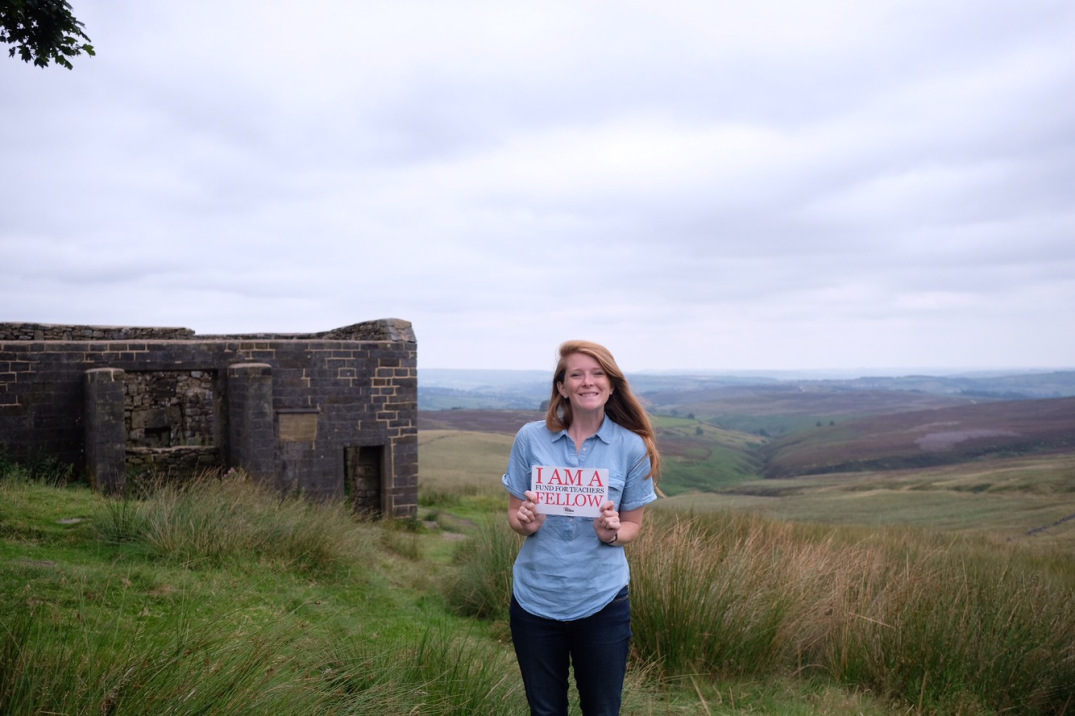Reader, I Studied Her

Charlotte Brontë, who sent her Jane Eyre manuscript to a London publisher on this date in 1847, wrote, “Your claim to superiority depends on the use you have made of your time and experience.” This summer, Amanda Kingston (Odyssey Leadership Academy – Oklahoma City) used her time (and a Fund for Teachers grant) to research the Brontë sisters, especially Charlotte – regarded as “the first historian of the private consciousness.”
On my Fund for Teachers fellowship, I navigated through five European countries in the hopes of learning more about Carol Gilligan’s work on the ethic of care in connection to the lives and histories of women. Among the women I journeyed to “meet” were Charlotte, Emily, and Anne Brontë, authors and sisters.
Haworth, England, is a small town that has capitalized on the mythology of the Brontë family. It’s hard to know if the Brontës modeled their stories after the environment of Haworth, or if Haworth has wrapped itself up in the Brontës. Whether it’s chicken or egg, at the heart, they’re inseparable. And, if you can’t get enough of the gothic atmosphere, you can hike out to the Brontë Waterfall across the moors and even farther to Top Withens, a possible location for the Wuthering Heights of Emily’s imagination. In the mist and among the heather you can almost hear Cathy still calling for Heathcliff.
The Brontë Parsonage Museum itself is in the midst of celebrating the 200th anniversaries of the Brontë children: for 2017, this is Branwell. The small parsonage is preserved beautifully, with portraits of the family hung in each room; the table where the women bent over needlework, writing, and dinners; and the study of the family patriarch, Patrick Brontë, complete with his spectacles and magnifying glass. The staff were enthusiastic and kind, offering up knowledge about the family not with an air of pretension, but rather as though talking warmly about old friends. The Brontës are very much real people to this crowd. Prior to this fellowship, I did not know much about the Brontës. I did a quick reread of Wuthering Heights and Jane Eyre earlier this year, and watched the BBC television special To Walk Invisible. The production worked closely with the Brontë Society and the museum also includes stills and costumes from the series.
For more on Jane Eyre’s iconic line “Reader, I married him,” click here.
In researching before the trip, I learned that in the original publications, the sisters chose not to use their given names. Instead, they used pseudonyms: Currer, Ellis, and Acton Bell. Charlotte explained after the deaths of Emily and Anne in 1848 and 1849 respectively, they wanted their work taken seriously, not frowned upon as womenly nonsense nor praised patronizingly as female folly. The Brontës were real writers with real things to say about the real world around them. And really, in 1847 when Jane Eyre was published, only male authors were taken seriously. The museum even includes a letter from a poet Charlotte admired advising her that writing was not for women.
I realized, a few days before in Chawton, that there is a reason we don’t say that Jane Austen’s books are about the human experience, though they certainly include suffering, trials, family, love, and loss. (The Jane Austen Society, coincidentally, is celebrating her life with the bicentennial of her death this year, as well.) The Brontës recognized this also, and when Charlotte sent Jane Eyre to be published she wanted the story of a young governess, a deeply misguided Mr. Rochester, and a “madwoman” in the attic to be a story received with the utmost sincerity and gravity, a story of human experience- not just male or female. And it was: Jane Eyre became the talk of London and new editions came out almost immediately. It’s a story of human experience and human emotions that belong to all of us, and I believe people recognized this, despite knowing the true identity of the author.
I’ll be honest, I was not a Brontë fan before visiting the parsonage. I enjoyed their books, yes, and they were interesting figures to me. But I wasn’t a “fan.” However, there is something about walking in the home of a person, seeing their correspondence and their village, walking across the moors of their lives for even just a day that spins stories to a different light. It makes you not just a fan, but a friend. I learned more about their heart and the courage they had to put their stories out to the world, and to put themselves in their stories.
I don’t think that it’s any accident that the original title of Charlotte’s first novel was Jane Eyre: An Autobiography.
Amanda serves as both a mentor and humanities teacher at Odyssey Leadership Academy in Oklahoma City and previously worked as a teacher in Louisiana’s public education sector. She is passionate about creating courses that focus on justice and empowering students to enrich and transform the community around them.
 Back to Blogs
Back to Blogs